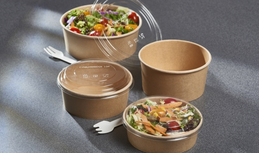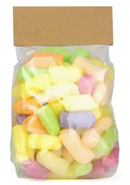Bioplastics & Compostables
"The best thing you can do environmentally is not create any waste in the first place".
Dr Jenna Jambeck, University of Georgia, 2020.
Dr Jenna Jambeck, University of Georgia, 2020.
The problems:
- When some biodegradable plastics decompose in landfills, they produce methane gas. This is a very powerful greenhouse gas that adds to the problem of global warming.
- Biodegradable plastics, bioplastics & compostables don't always readily decompose (see below).
- Bioplastics are made from plants such as corn, so land that could be used to grow food is being used to "grow plastic" instead. By 2014, almost a quarter of US grain production was expected to have been turned over to biofuels and bioplastics production.
- Growing crops to make bioplastics comes with the usual environmental impacts of intensive agriculture, including greenhouse emissions from the petroleum needed to fuel farm machinery, and water pollution caused by runoff from land where fertilizers are used in industrial quantities. In some cases, these indirect impacts from "growing" bioplastics are greater than if we simply made plastics from petroleum in the first place.
- Bioplastics and biodegradable plastics cannot be easily recycled. To most people, PLA looks very similar to PET (polyethylene terephthalate) but, if the two are mixed up in a recycling bin, the whole collection becomes impossible to recycle. There are fears that increasing use of PLA may undermine existing efforts to recycle plastics. (www.explainthatstuff.com/bioplastics)
- Compostables should not be put in council food-waste compost bins because they take much longer to break down so unless you have a dedicated waste stream for them is the option to bury them in your garden?
Examples of bioplastics & compostables:

PLA (Polylactic acid) is a bioplastic made from corn starch commonly used for
bags, cutlery, cold cups, hot cup/container lining and straws.
CPLA is a form of heat-resisitant PLA
(chalk is added to turn it white or charcoal to turn it black).
RCPLA is ‘Recycled CPLA’. PLA based products can be either recycled or composted but only in industrial composting facilities. (www.sas.org.uk, 2020, www.Biofutura.com, 2020)
bags, cutlery, cold cups, hot cup/container lining and straws.
CPLA is a form of heat-resisitant PLA
(chalk is added to turn it white or charcoal to turn it black).
RCPLA is ‘Recycled CPLA’. PLA based products can be either recycled or composted but only in industrial composting facilities. (www.sas.org.uk, 2020, www.Biofutura.com, 2020)

Bagasse is a by-product of sugarcane production. It’s not bioplastic, just pressed sugarcane. This can be “cold”/home or “hot”/industrially composted. Some commercial bagasse is certified to breakdown in 12 weeks in a commercial composting facility. However, some is not accredited for home composting. (www.decentpackaging.co.uk, 2020, www.sas.org.uk, 2020)

Cellophane is a wood pulp cellulose based material. Like other bioplastics it must be “hot”/industrially composted, though there are dissolving wood pulp cellulose based materials on the market that can be “cold”/home or “hot”/industrially composted. "When being composted , it must biodegrade to a minimum of 90% within 6 months although in reality this can be achieved in less that 45 days with industrial composting. Home composting will be at a lower temperature and take longer". (www.eco-craft.co.uk, 2019, www.sas.org.uk, 2020)
It is always worth checking with suppliers and manufacturers how sustainable alternatives are disposed of. Most can't go in the home compost bin nor the recycling bin and need their own dedicated waste stream. Generally pick compostable over bio-degradable but be aware that many compostable products are not home compostable and need to go to special composting facilities, of which there are very few in the UK. Our message is to avoid single use as much as you can, by encouraging elimination, reuse and recycling.
How well do compostables live up to their claim?
Members of Garden Organic recently carried out a home-compost test on four items:
"The clear winners in the compostability stakes were the cardboard and the bagasse plate. After 6 months, these materials had completely degraded in more than 80% of people’s compost heaps and in 95% of heaps after 12 months. The plastic fork was the obvious loser showing virtually no degradation, even after a year.
The bag was not such a clear story. Despite being marked as home compostable, it’s composting fate showed a high degree of variability among our members. After 12 months, the bag had only completely degraded in 26% of heaps. Among the remainder of people, their bags were in various states of degradation. We could not find any clear correlation between the rate of degradation and the type of compost heap or its temperature."
You can read more about their experiment here:
www.gardenorganic.org.uk/compostable-packaging-how-well-does-it-live-its-claim
- a small piece of cardboard
- a bagasse plate
- a compostable caddy bag
- a fork made from recycled plant based material
"The clear winners in the compostability stakes were the cardboard and the bagasse plate. After 6 months, these materials had completely degraded in more than 80% of people’s compost heaps and in 95% of heaps after 12 months. The plastic fork was the obvious loser showing virtually no degradation, even after a year.
The bag was not such a clear story. Despite being marked as home compostable, it’s composting fate showed a high degree of variability among our members. After 12 months, the bag had only completely degraded in 26% of heaps. Among the remainder of people, their bags were in various states of degradation. We could not find any clear correlation between the rate of degradation and the type of compost heap or its temperature."
You can read more about their experiment here:
www.gardenorganic.org.uk/compostable-packaging-how-well-does-it-live-its-claim
